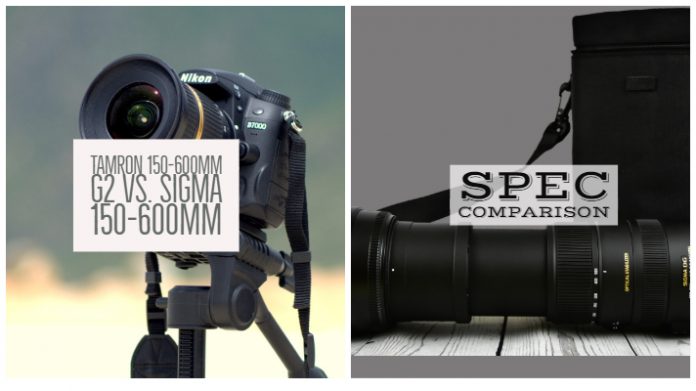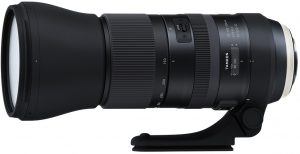If you are looking for a good quality telephoto lens, you have landed on the right post. Today here at LensXP, we are discussing two of the best budget telephoto zoom lenses available out there in the market. If you are already looking for one, we consider that you might understand how a telephoto lens is different from a regular zoom lens. Still, here is a quick difference comparison between two telephoto lenses which might help you, understand them more: Tamron 150-600mm g2 Vs. Sigma 150-600mm
A zoom lens goes from wide angle to telephoto range using its variable focal length. In other words, you can change smoothly from a long shot to a close-up or vice versa by varying the focal length. The lens element assembly allows the users to change the angle of view using its focal range. However, the convenience of using a variable focal length design on a lens assembly comes at the cost of the following:
- Image resolution data loss at maximum aperture
- More heavy than conventional lenses
- Longer dimensions
- Inaccuracy in focussing the subject, especially in low light
- High price due to more lens elements (24 Elements in 16 Groups on the Sigma)
The Tamron and Sigma lenses comes with a range of 150mm-600mm of focusing distance. To put it even more simply, it goes from low focal length value to high focal length value. The telephoto lens is made to work in high telephoto range. The view you get on your camera is highly dependent on the focal length of the lens you are using. If the value is extended, the things in front of camera appear magnified. If the focal length is short, it captures full area and objects appear smaller. Technically, there is particular meaning to a telephoto lens, in simple words, a telephoto lens is a lens with really long focal length.
So coming back to our topic, today, we are discussing following lenses:
Tamron 150-600mm g2 Vs. Sigma 150-600mm
First, we will look at the Pros & Cons of these lenses. See below:
| Pros & Cons | Tamron-sp-150-600mm (F5.0 -6.3) | Sigma 150-600mm F 5.0 -6.3 |
| Has full-time manual focus | 50mm shorter minimum focal length | |
| Front element doesn’t rotate | Has rounded aperture blades | |
| 18f smaller aperture at maximum focal length 40f vs 22f | 0.1m shorter minimum focus distance (2.6m vs 2.7m) | |
| 850g lighter – 2.01kgvs2860g | ||
| 10f smaller aperture at minimum focal length 32f vs 22f | ||
| Comes with reversible Lens hood |
We will be comparing all the important technical aspects and specifications side by side so you can get a better idea. Moreover, we will discuss all the major differences descriptively and understand how they leave an impact on the overall performance of the lens. So without any more delay, here we begin:
Specs Comparison:
General
| Specifications | Tamron 150-600mm G2 [amazon_link asins=’B00HR6IPSE’ template=’PriceLink’ store=’foi04-20′ marketplace=’US’ link_id=’f61f6de5-6bfe-11e8-9a26-a5283352b6ca’] | Sigma 150-600mm Sports [amazon_link asins=’B01BXUJF2O’ template=’PriceLink’ store=’foi04-20′ marketplace=’US’ link_id=’042906e1-6bff-11e8-b495-a95213fa6910′] |
| Packaged Quantity | 1 | 1 |
| Diameter | 4.3 in (108.4mm max) | 4.8 in |
| Length | 10.2 in | 121 x 290.2mm & 4.8×11.4in |
| Weight | 1.95 kg [68.78 oz] | 2.9 KG [100.9 oz] |
| Accessory Type | Lenses | Lenses |
| Manufacturer | Tamron USA, Inc | SIGMA |
Dimension & Weight:
Let’s talk about the basic things first. Tamron G2 has a diameter of 4.3 and is 10.2 inches long. On the other hand, Sigma Sports has 4.8 inches in diameter and is almost a foot long. This difference is because Tamron G2 has a (13, 21) lens structure and Sigma Sports has a (16, 24) lens structure. We will discuss more this later in the post. It also leaves an impact on their weight. Tamron G2 weights 4.43 lbs while Sigma Sports is a lot bulkier and weighs 6.31 lbs. These figures do not affect their performance, but lighter and compact lenses are more convenient to carry around or operate. So Tamron 150-600 mm G2 is the edge here.
Carrying Case
| Specifications | Tamron 150-600mm G2 | Sigma 150-600mm Sports |
| Included Accessories | dust cap lens cap lens hood tripod collar | dust cap lens cap lens case lens hood shoulder strap |
Carrying Accessories:
The table above shows various carrying accessories you get with each lens. Both Tamron G2 and Sigma Sports ship with a dust cap (to be attached on the front when not in use), lens cap (to be connected to the back) and a lens hood. The hood is used to protect lens glass from harmful rays when shooting in daylight. However, it is not as useful as various lens filters (or polarizers) available out there. Still, better than nothing. Moreover, Tamron G2 offers a Tripod Collar, which is essential for mounting heavy lenses on the tripod. Unfortunately, Sigma Sports doesn’t provide one. However, Sigma sports come with lens case and shoulder strap, which altogether make it convenient to carry the lens around. So as it is clear, both lenses have their advantages when it comes to included accessories.
Lens System
| Specifications | Tamron 150-600mm G2 | Sigma 150-600mm Sports |
| Type | Telephoto zoom lens | Telephoto Zoom Lens |
| Focal Length | 150 mm – 600 mm | 150 mm – 600 mm |
| Magnification | 0.25x | 5x |
| Image Stabilizer | Optical (4.5 stops (CIPA Standards Compliant) Using in VC MODE 3 ) | Optical |
| Smallest Aperture at minimum Focal Length | 32f | 22f |
| Intended For | 35mm SLR, digital SLR (Canon, Nikon, Sony) | 35 mm SLR, Digital SLR (Canon, Nikon, Sony) |
| Optical Zoom | 4 x | 6 x |
| Series | Di VC USD G2 | DG OS HSM |
| Lens Coating | Broad-Band Anti-Reflection coating (BBAR) Extended Bandwidth & Angular-Dependency coating (eBAND) Fluorine coating | Super Multi-Layer Coating Water and oil repellent coating on the front & rear lens elements |
| Mounting Type | Canon EF, Nikon FX, Sony | Nikon F (Canon, Nikon, Sigma) |
| Special Functions | Tele, zoom | Tele, Zoom |
| Lens Aperture | f/5.0-6.3 | f/5.0-6.3 |
| Minimum Aperture | f/32 – f/40 (F/32-40) | f/22 |
| Min Focal Length | 150 mm | 150 mm |
| Max Focal Length | 600 mm | 600 mm |
| Min Focus Distance | 7 ft | 8.5 ft |
| Focus Adjustment | automatic, manual | Automatic, Manual |
| Zoom Adjustment | manual | Manual |
| Max View Angle | 16.25 degrees (16°25′ – 4°8′ (for full-frame format) 10°38′ – 2°40′ (for APS-C format)) | 16.4 degrees (16.4º-4.1º) |
| Min View Angle | 4.8 degrees | 4.1 degrees |
| Group Qty | 13 | 16 |
| Element Qty | 21 | 24 |
| Filter Size | 95 mm | 105 mm |
| Diaphragm Blades | 9 | 9 |
| Features | LD glass, Ultrasonic Silent Drive (USD) VC (Vibration Compensation) full-time manual focusing moisture-resistant | ELD (Extraordinary Low Dispersion) glass FLD glass Hyper Sonic Motor (HSM) SLD (Special Low Dispersion) glass Sigma USB dock compatible Dustproof Splash-proof |
Let us take you a little bit deeper in technical perspective. Note that we will be discussing the differences in the above table, and not the similarities; since it does not simply make any sense to discuss in what criteria these lenses are similar. So, here we go:
Magnification Ratio:
In simple words, magnification measures the ability of a lens to make the objects appear bigger in produced images, especially for macro photography. It is a bit different than zooming / resolution, which is ability to make objects clearer and sharper. As shown in the table above, Tamron G2 offer 1/3.9 magnifications while Sigma Sports offers 1/5 magnification. A 1/3.0 magnification ratio means the leans can enlarge the object 3.9 times bigger than it is actually, without losing the sharpness. Means, it can make a 3 cm long cube appear as ~12cm long. A 1/5 magnification ratio means objects can appear 5 times bigger compared to their actual size. So now you can tell that Sigma Sports is much better when it comes to Magnification Ratio.
Lens Coating:
As shown in the table above, Tamron G2 Comes with Broad-Band Anti-Reflection coating (BBAR), Extended Bandwidth + Angular-Dependency coating (band), and Fluorine coating. All of them work together to protect the outer layer of the lens glass. Broad-band anti-reflection coating helps to reduce the fuss caused by sunlight or to reduce the reflections from final image results directly. On the other hand, Sigma Sports comes with a super multi-layer coating. They haven’t specified what exactly this “Multi-Layer” consist of, but we hope it at least consists of necessary protection for lens glass. Whatever it is, we highly recommend not to rely on them and use a protective filter instead.
Compatibility:
Both Tamron 150 – 600 mm G2 and Sigma 150 – 600 mm Sports are meant to be used with 35 mm SLRs and Digital SLRs. You can use Tamron G2 with any Canon SLR / DSLR offering Canon EF mount support. Sigma Sports is compatible with all Nikon SLRs / DSLRs offering Nikon F mount support.
Aperture:
Aperture allows you to control the light reaching to camera image sensor. Ultimately, the aperture value determines how darker your image will be. The aperture value range is same for both Tamron 150-600mm G2 and Sigma 150-600mm Sports. However, with Sigma Sports, you can lower the aperture down to f/22. On the other hand, Tamron sports allow f/32 as the lowest aperture value. This will affect the performance and final result images when you are shooting in bright daylight.
Minimum Focus Distance:
It is merely the shorter distance from which a lens can focus on the object in front of it. Tamron has 7 ft minimum focus distance, which means you need to be at least 7 ft away from the primary purpose to focus it. On the other hand, with sigma sports, you need to have at least 8.5 ft of distance from the subject to target it. This only affects the experience while capturing close up shots. Since no one uses a telephoto lens for capturing close-ups, we don’t think this matters at all while comparing these two lenses.
As diagram of both lenses is the difference, they need a different size of filters. Tamron G2 requires a 95 mm filters, and Sigma Sports requires a 105 mm filter. Moreover, their body structures are different as well. We mentioned these factors at the bottom since they do not affect performance in any way.
Conclusion:
We believe that we have discussed all the significant differences, which will help you to determine which lens fits best in your requirements. However, if you feel like we are missing something, or there is a question, doubt or suggestion on your mind, feel free to let us know in the comment section below, or contact us directly. Make sure you subscribe to our blog for regular tech updates right in your inbox. Thank You!



